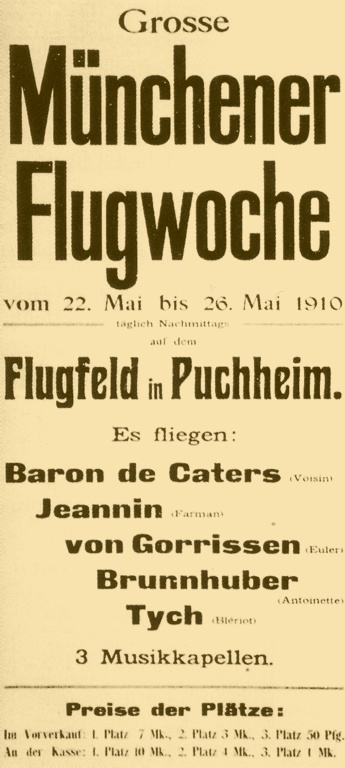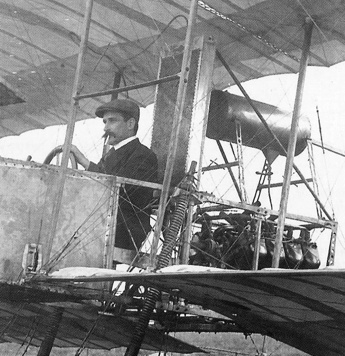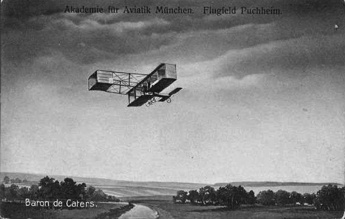Puchheim, Germany, May 22nd - 26th, 1910
The first aviation meeting in Bavaria - high winds and not much flying








Munich is the capital of Bavaria, which in 1909 although part of the
German empire was a kingdom with its own king. It was Germany's
fourth biggest town, with a population of around 600,000.
The Munich "Akademie für Aviatik" was founded in 1909, mainly
by members of the Royal Bavarian Automobile Club. Its main aim was
promoting aviation, particularly by flying dirigibles and other flying
machines. This included building an airfield with all necessary
installations, but also creating a library and a museum and the
awarding of prizes for competitions. Suitable grounds for an airfield
were found in the village of Puchheim, 15 kilometres west of central
Munich, where 76 hectares of moorland was bought and leased. A modern
and completely equipped airfield with a two-kilometre race course was
built.
It was decided to celebrate the opening of the airfield by organizing
an "aviation week" of five days in the end of May, starting
less than a week after the Berlin-Johannisthal spring meeting.
Five pilots were engaged. Emil Jeannin, Baron Pierre de Caters and
Ellery von Gorrissen came directly from the Berlin meeting, where the
two former had been very successful. They were accompanied by Belgian
Jules Tyck on a Blériot and local Munich man Simon Brunnhuber on one of
the Antoinettes bought by Walther Huth, who would later start the
Albatros company.
The program included seven different contests, for total flying time,
longest non-stop flight, highest altitude, speed over both one and five
laps of the course, cross-country flight and passenger flight.
The airfield was officially opened the day before the meeting, in the
presence of press and invited guests, and de Caters was asked to make a
couple of flights. He had difficulties taking off from the uneven
field, but finally managed a flight of three laps. He then tried to
make a passenger flight, but had to give up when the propeller struck
the ground.
Sunday 22 May
The weather on the opening day of the meeting was windy, with wind
speeds reaching around 13 m/s. It was intended that flights would start
at four o'clock, but due to the strong and gusty winds the delays
went on and on. For the first couple of hours the more than 20,000
spectators were patient and let themselves be amused by the music from
the three orchestras.
At around six o'clock the winds began to decrease, but by then the
most impatient spectators in the cheapest spectator area at the far
side of field had had enough of waiting and climbed over the fences.
The few policemen and the fire brigade could do nothing as a big crowd
advanced towards the hangars, headed by a man waving a signal flag
stolen from the officials. Things looked nasty, but Baron de Caters
saved the peace by rolling out his Voisin. He had some mechanical
problems, but von Gorrissen let him use his machine and when the field
had been cleared he made the first flight, at around 18:45. He was in
the air for twelve minutes, completing six laps of the course.
Afterwards Jeannin made a one-lap flight, but had to land with engine
problems. The day's activities closed at 19:45.
Monday 23 May
The weather on the second day was even windier, with wind speeds
reaching 15 m/s. All flying was impossible and the tickets of the
disappointed spectators were refunded.
Tuesday 24 May
The weather was better on the third day, but the 10,000-12,000
spectators still had to wait until five o'clock before de Caters
rolled out his machine, deciding to fly despite wind speeds of 6-7 m/s.
At 17:15 he made a short flight, posting a time of 2:32 for the one lap
speed contest, but since the clouds started to look threatening he
decided to land. Half an hour later Jeannin made a short but rather
high flight. De Caters and Jeannin both made a couple of more short
flights before the flying stopped at around half past seven, and von
Gorrissen and Brunnhuber each made one. Brunnhuber had to give up his
last effort since the engine of his Antoinette didn't run well.
After the end of the say's flights de Caters led the standings in
the total flight time contest with 34:58, before Jeannin (16:34) and
von Gorrissen (7:58).
Wednesday 25 May
The meeting was honoured by a visit of princes Leopold and Ferdinand of
Bavaria and the three princesses Gisela, Klara and Pilar. It was still
a bit windy, and since the wind was blowing from the south-west there
was tailwind from the hangar area towards the starting line that made
it difficult to take off.
The winds didn't stop von Gorrissen, who made a cross-country
flight over the nearby villages of Puchheim and Aubingen south and
south-east of the airfield. He flew above roofs and chimneys at
altitudes estimated to up to 150 metres. After a flight of 7:33 he
landed safely. He made two further flights, in total 17:45. Baron de
Caters flew a couple of laps during a flight of 7:12 and Jeannin made a
flight of 14:25.
Thursday 26 May
After a rainy and windy morning calmer weather finally arrived on the
last day of the meeting, but the clouds were still threatening.
10,000-12,000 paying spectators lined the field, in addition to the
many who watched from outside the fences. 8,000 people had travelled to
the airfield on the extra trains provided.
Tyck was first in the air and made his first flight of the meeting
already at three o'clock, but it was only a short straight hop.
When had had returned to the hangars it started to rain. Then de Caters
made a fine flight of five or six laps in von Gorrissen's machine.
De Caters' engine had failed and had been completely taken apart by
his mechanics, who blamed the problems on bad fuel and oil. The race
committee decided that in the total flight time contest the time that
de Caters flew on von Gorrissen's machine would be credited
fifty-fifty to the two pilots. Tyck made another flight, but after
three quarters of a lap he was blown outside the airfield wall and had
to land in a field. The landing went well, but he couldn't take off
and fly back, so his machine had to be lifted and carried over the
wall.
Around 17:45 Jeannin made his effort for the 10-kilometre speed
contest. He posted a time of 10:41, which would eventually win him the
prize, and then kept flying for a total 24 minutes. His fastest lap was
2:06. While Jeannin was flying, Brunnhuber brought out his machine.
After a good take-off he flew a lap, but his engine started to miss and
he was forced to land. The landing was rather hard and the front skid
dug into the ground. The landing gear was ripped off and the propeller
and the right wing were damaged, but the pilot was unharmed. The
machine lay on the ground in the middle of the field, "like a
wounded bird with its wings spread", and had to be disassembled
and brought back to the hangars.
Jeannin only made a short stop and took off again for a flight that
lasted 25:27.6, the longest of the meeting. He reached an altitude of
80 metres and impressed the crowds by shutting down his engine and
gliding, before restarting it again. He also improved his time in the
single-lap speed contest, to 1:55. Tyck's Blériot had been returned
to the hangars and at seven o'clock he made a flight of one and a
half lap. De Caters made a flight of 13:30.6. Von Gorrissen took over
the machine and made two flights. The first lasted more than 13
minutes, but the second was cut short by problems with the elevators,
which didn't work well. At the last moment, at 19:54, Jeannin took
off to go for the altitude contest. He flew in tight circles and
quickly reached 120 metres. His flight over the illuminated airfield
"offered a wonderful picture" and was a worthy end to the
meeting.
Conclusions
The weather didn't allow the five flyers to accumulate even three
and a half hours of total flying time over the five days, which was of
course a disappointment to both spectators and organizers. The results
were hardly sensational, but under the circumstances it was of course
unrealistic to expect any spectacular performances. Jeannin made a
clean sweep of all the events, with a total flying time of 1 h 29:19,
the longest non-stop flight of 25:27, a highest altitude of 120 metres
and the best speeds over both two and ten kilometres. The second
busiest flyer was von Gorrissen, who was in the air for 1 h 09:09.
Despite the lack of action the meeting was a crowd success and
attracted visitors from all categories of people: "capuchin
friars, politicians, companies of soldiers with their officers, farmers
in traditional costumes, confirmands and even the inmates of a home for
young boys with their teacher". Nevertheless, the ticket sales and
other income from the meeting did not cover the expenses of building
the airfield and organizing the event. The Akademie was already
planning a second meeting for September, but it was overstretching its
finances and would be threatened by bankruptcy after the two
meetings.
 Back to the top of the
page
Back to the top of the
page
